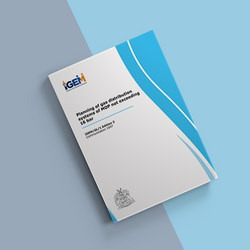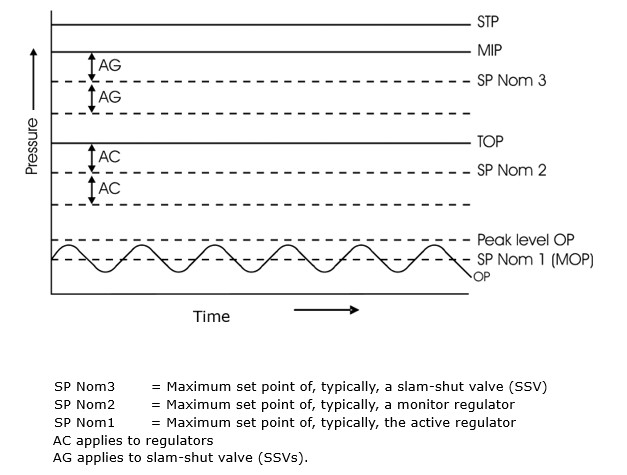IGE/GL/1 Edition 3 - Planning of gas distribution systems of maximum operating pressure (MOP) not exceeding 16 bar

This guidance contains advice on the planning and design of Natural Gas distribution systems of MOP not exceeding 16 bar. It provides practical guidance to support Gas Safety (Management) Regulations and Pipelines Safety Regulations. It includes the arrangements and agreements required between different Gas Transporters and Network owners at system boundaries, to ensure the continuity of gas flow.
It is intended to be used by competent persons in the planning and design of systems and for the ongoing monitoring and reinforcement of existing systems. It contains specific details of:
- Legal considerations
- Planning process
- System boundary interfaces
- Where to find guidance on route planning of distribution systems
- Where to find guidance on selection of pipe materials
- System monitoring and reinforcement
- Sizing of pipes
- Sizing of Pressure Regulation Installations
- Additional considerations for the planning of systems of MOP > 75 bar
- Records and documentation.
Introduction
1.1 This Standard supersedes IGE/GL/1 Edition 2, Communication 1718, which is obsolete.
1.2 This Standard has been drafted by an Institution of Gas Engineers and Managers (IGEM) Panel, appointed by IGEM’s Gas Transmission and Distribution Committee, and has been approved by IGEM’s Technical Coordinating Committee on behalf of the Council of IGEM.
1.3 This Standard stipulates requirements for the planning and network modelling of distribution systems so that as far as possible, continuity of gas supply is maintained to consumers on the system and at sufficient pressure that their appliances continue to operate at all times, unless load shedding has been initiated (through commercial agreements or in an emergency situation).
1.4 This Standard applies to planning systems with maximum operating pressure (MOP) up to and not exceeding 16 bar in accordance with IGEM/TD/3 and IGEM/TD/4 as appropriate.
1.5 The relevant parts of this Standard may be cited in the gas transporter's (GT’s) Safety Case, however the Health and Safety Executive (HSE) will need to be satisfied that the parts are appropriate and have been properly applied in each case.
1.6 IGEM has adopted the terms and definitions used in European standards for pressure i.e., maximum operating (MOP), operating pressure (OP), maximum incidental pressure (MIP) and strength test pressure (STP). Figure 1 explains these terms.

FIGURE 1 - PRESSURE TERMINOLOGY
1.7 This Standard make use of the terms “must”, “shall” and “should” when prescribing particular procedures. Notwithstanding clause 1.10:
- the term “must” identifies a requirement by law in Great Britain (GB) at the time of publication
- the term “shall” prescribes a requirement which, it is intended, will be complied with in full and without deviation
- the term “should” prescribes a requirement which, it is intended, will be complied with unless, after prior consideration, deviation is considered to be acceptable. Such terms may have different meanings when used in Legislation, or HSE Approved Codes of Practice (ACoPs) or Guidance, and reference needs to be made to such statutory Legislation or official Guidance for information on legal obligations.
1.8 It is now widely accepted that the majority of accidents in industry generally are in some measure attributable to human as well as technical factors. People who initiated actions that caused or contributed to accidents might have acted in a more appropriate manner to prevent them.
To assist in the control of risk and proper management of these human factors, due regard is to be taken of HSG48 and HSG65.
1.9 The primary responsibility for compliance with legal duties relating to health and safety at work rests with the employer. The fact that certain employees, for example “responsible engineers”, are allowed to exercise their professional judgement does not allow employers to abrogate their primary responsibilities. Employers is required to:
- have done everything to ensure, so far as is reasonably practicable, that there are no better protective measures that can be taken other than relying on the exercise of professional judgement by "responsible engineers
- have done everything to ensure, so far as it is reasonably practicable, that “responsible engineers” have the skills, training, experience and personal qualities necessary for the proper exercise of professional judgement • have systems and procedures in place to ensure that the exercise of professional judgement by “responsible engineers” is subject to appropriate monitoring and review
- not require “responsible engineers” to undertake tasks which would necessitate the exercise of professional judgement that is not within their competence. There should be written procedures defining the extent to which “responsible engineers” can exercise their professional judgement. When “responsible engineers” are asked to undertake tasks which deviate from this, they should refer the matter for higher review.
1.10 Notwithstanding clause 1.7, this Standard does not attempt to make the use of any method or specification obligatory against the judgement of the responsible engineer. Where new and better techniques are developed and proved, they are to be adopted without waiting for the modification of this Standard. Amendments to this Standard will be issued when necessary and their publication will be announced in the Journal of IGEM and other publications as appropriate.
1.11 Requests for interpretation of this Standard in relation to matters within their scope, but not precisely covered by the current text, are to be:
- addressed in writing to Technical Services, IGEM, IGEM House, High Street, Kegworth, Derbyshire, DE74 2DA; or
- emailed to [email protected].
These will be submitted to the relevant Committee for consideration and advice, but in the context that the final responsibility is that of the engineer concerned. If any advice is given by or on behalf of IGEM, this does not relieve the responsible engineer of any of their obligations.
1.12 This Standard was published in December 2021.
Scope
Note 1: Compliance with this Standard ensures that as far as is reasonably practicable, a system is able to maintain a minimum pressure at the maximum peak demand flow rate and that adequate arrangements are established to minimise the risk of a supply emergency (see Appendix 3).
Note 2: Within the GB, reference to NG is of a quality compliant with GS(M)R.
2.2 This Standard references the technical arrangements and agreements required between different GTs and non-GT network owners at system boundaries, to ensure there is sufficient transportation capacity.
2.3 This Standard is intended to be used by persons in the planning, modelling and design of systems and for the ongoing monitoring and development of existing systems where appropriate.
2.4 This Standard is intended to be used for systems as part of the Network (see IGEM/G/1) for network planning and modelling. Where a system is being designed to contribute diurnal storage provision for the overall Network using “linepack”, it may be appropriate to consider applying IGEM/GL/2. This Standard does not embrace the physical design, construction, integrity, operation and maintenance of systems nor does it address environmental issues covered by Legislation other than that mentioned in Section 3. Further information is contained in IGEM/TD/3 and IGEM/TD/4 as appropriate.
2.5 This Standard applies to the planning of new and replacement of, or extension to, existing installations. It is not retrospective, but it is recommended that existing installations be modified to meet this Standard when appropriate.
Note: Standards rarely cover the retrospective issue of existing installations. They can however set a basis for consideration of performance upon which a risk assessment can be developed.
2.6 All pressures are gauge pressures unless otherwise stated.
2.7 Italicised text is informative and does not represent formal requirements.
2.8 Appendices are informative and do not represent formal requirements unless specifically referenced in the main sections via the prescriptive terms “must”, “shall” or “should”.
